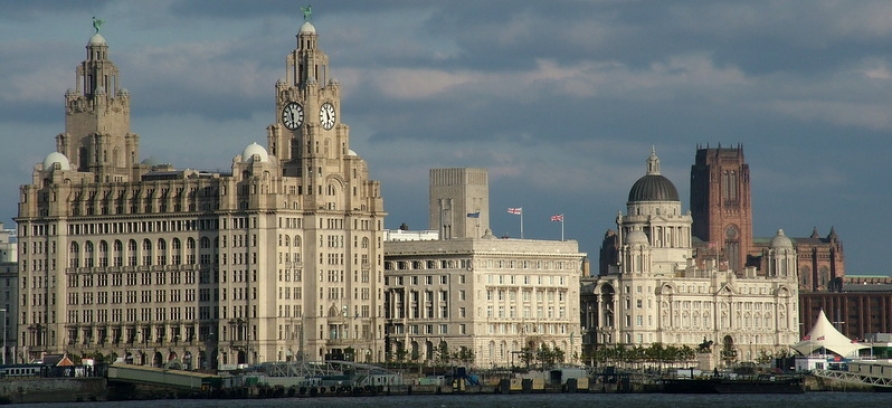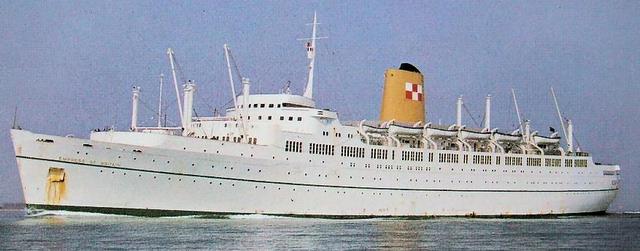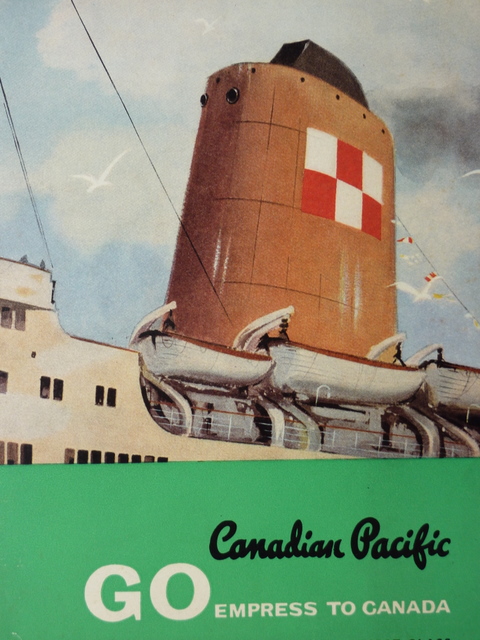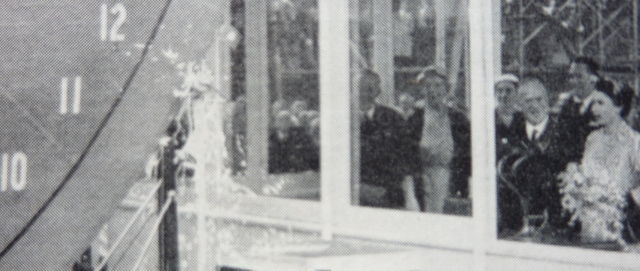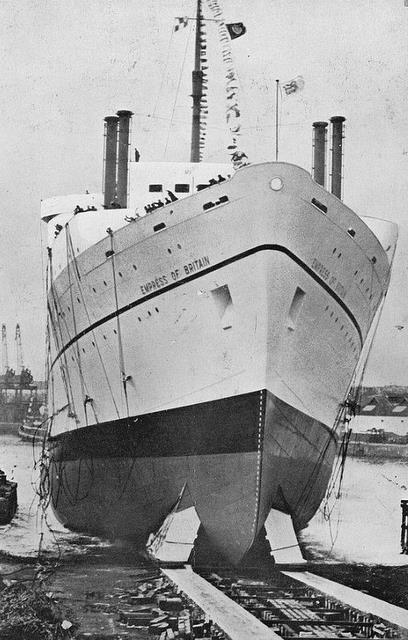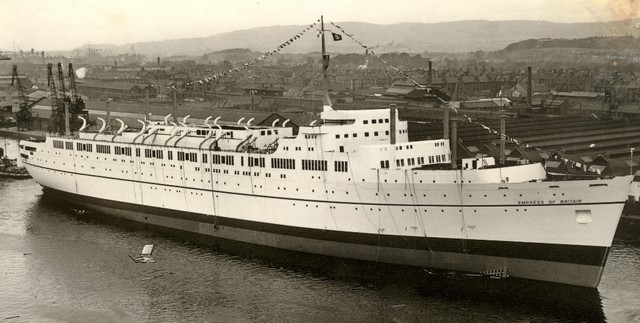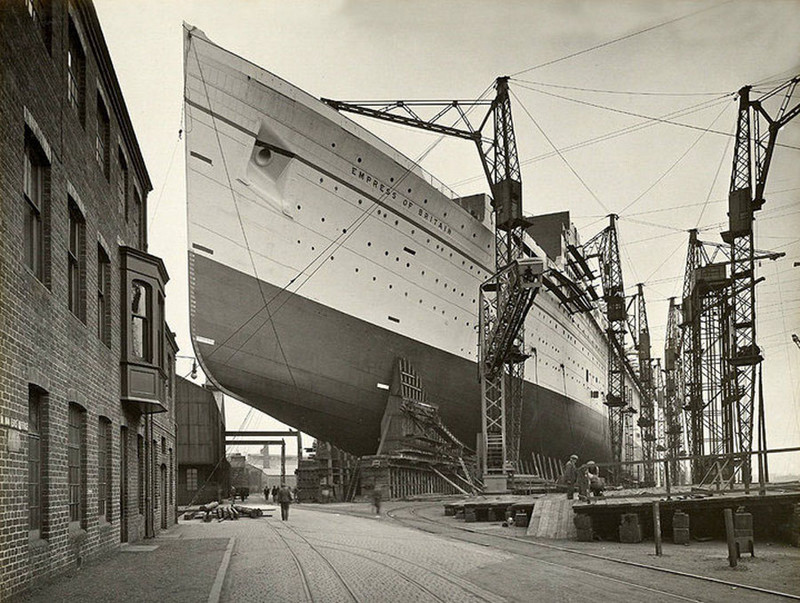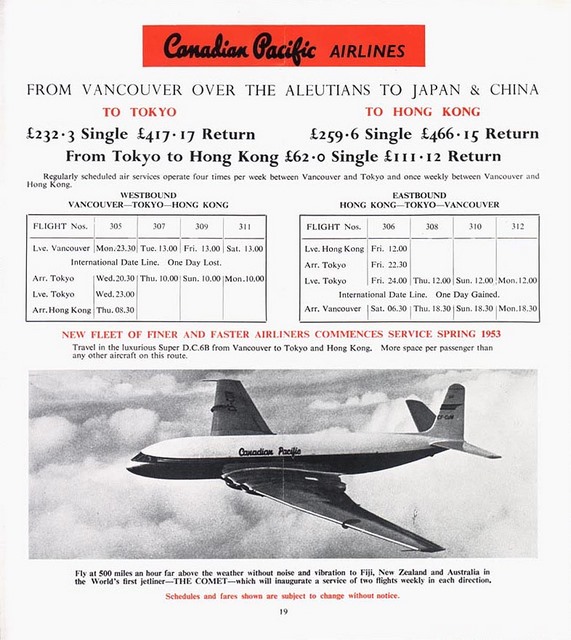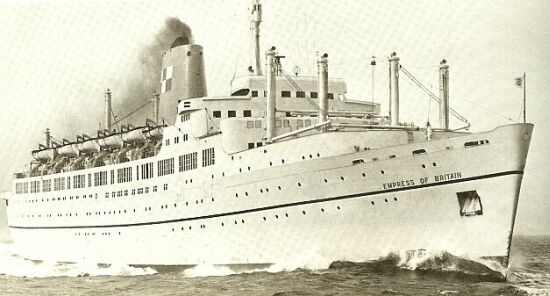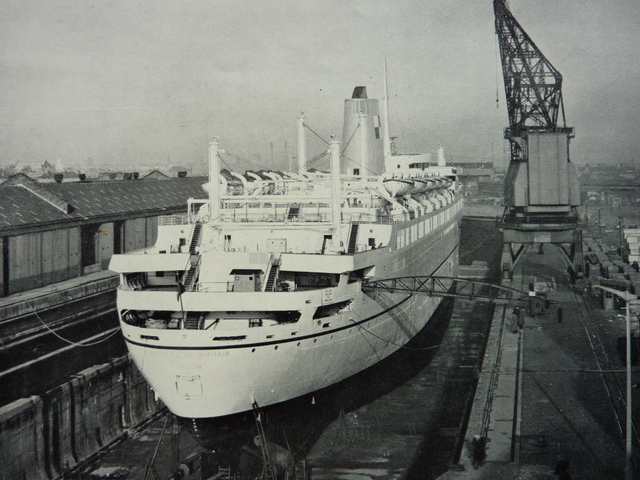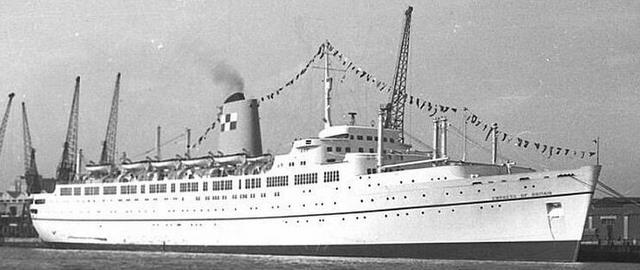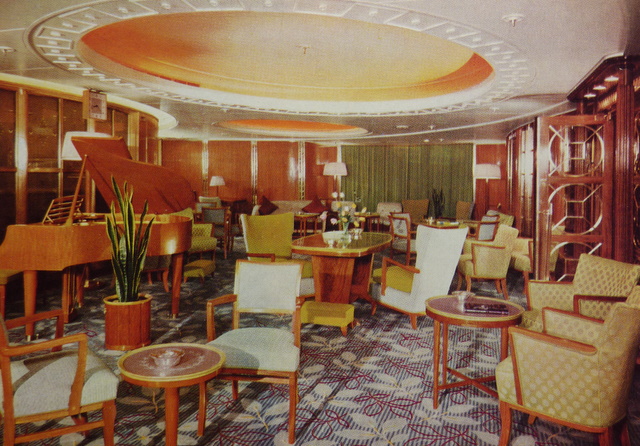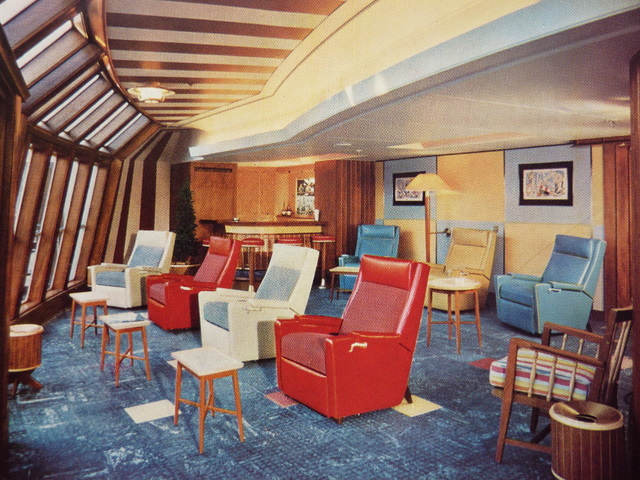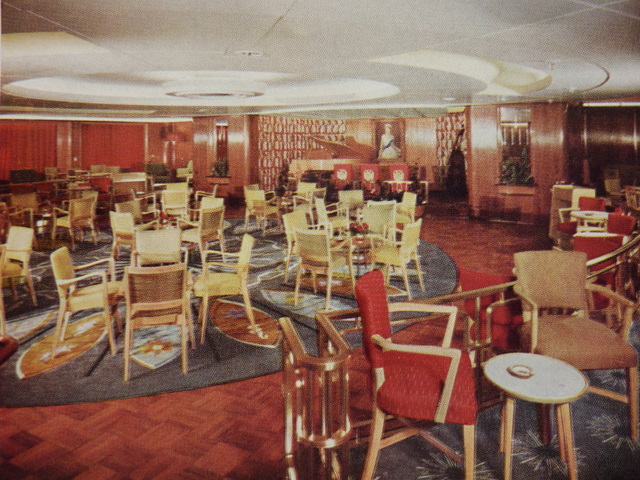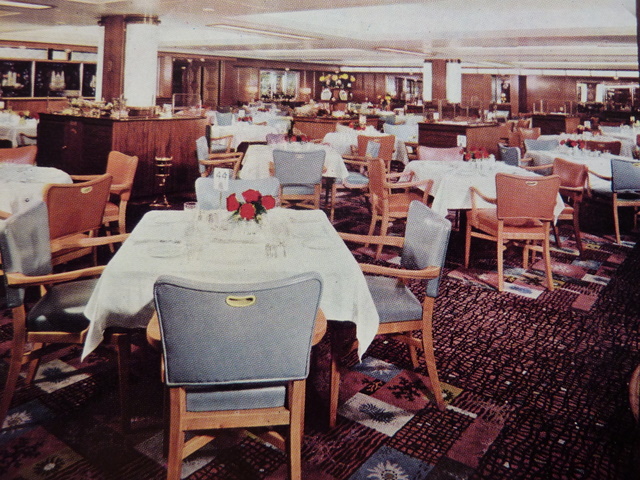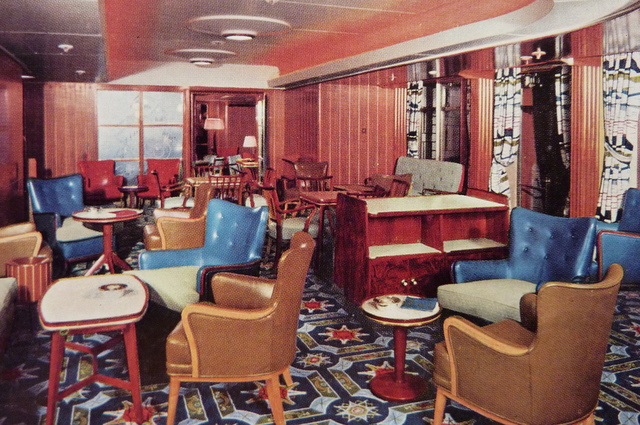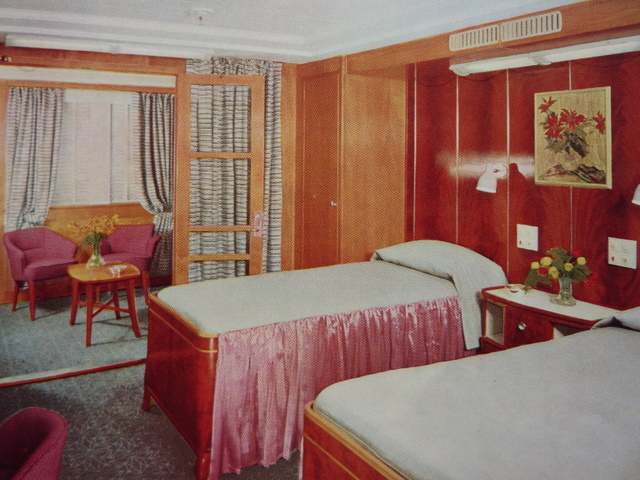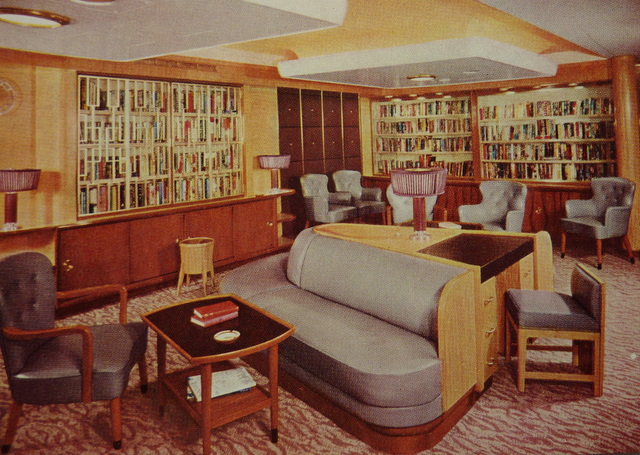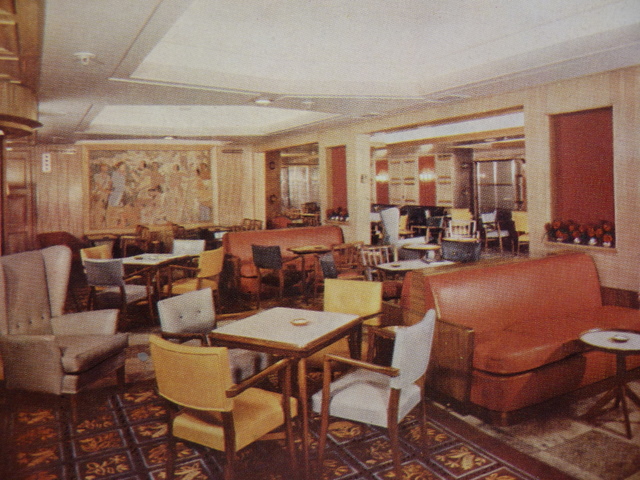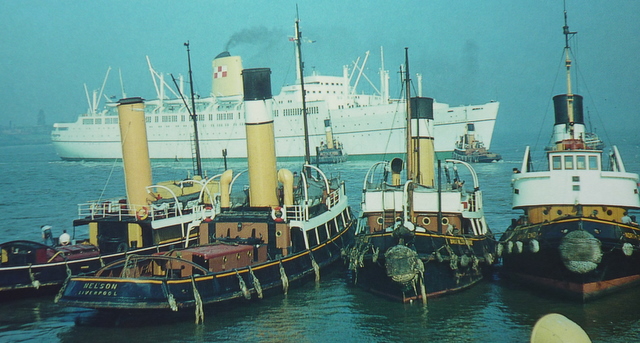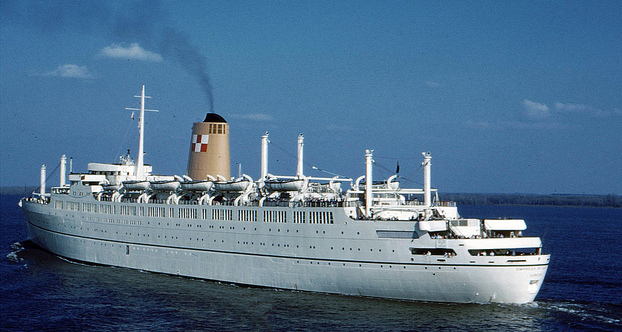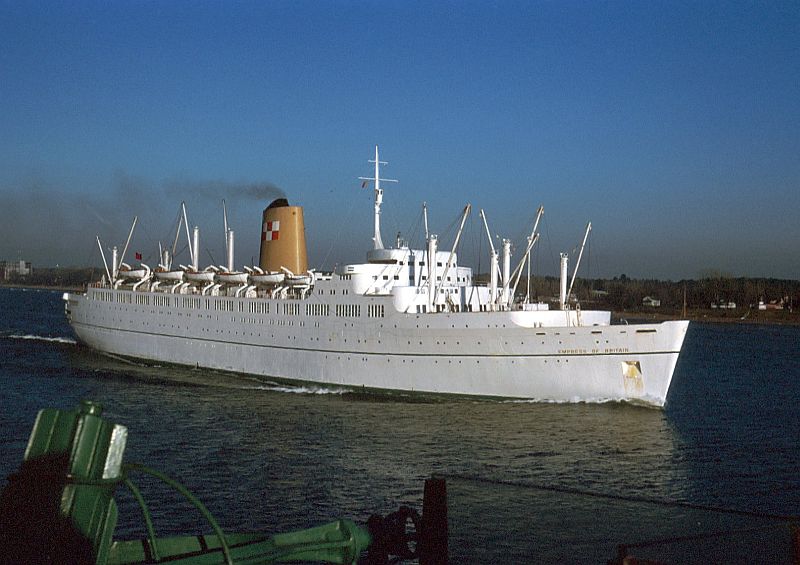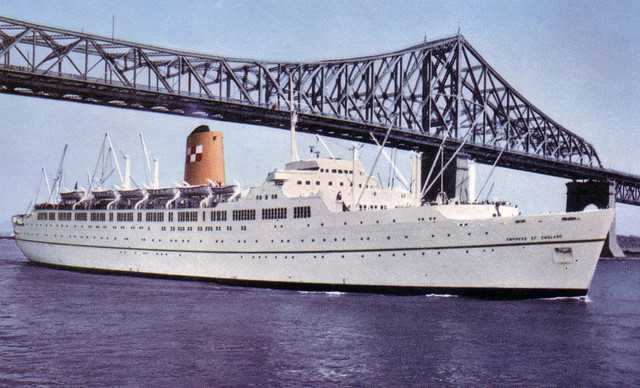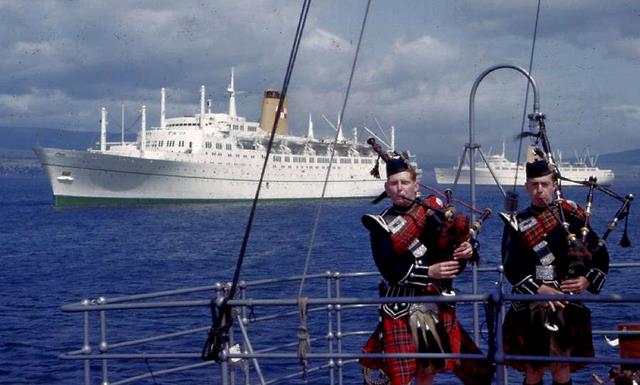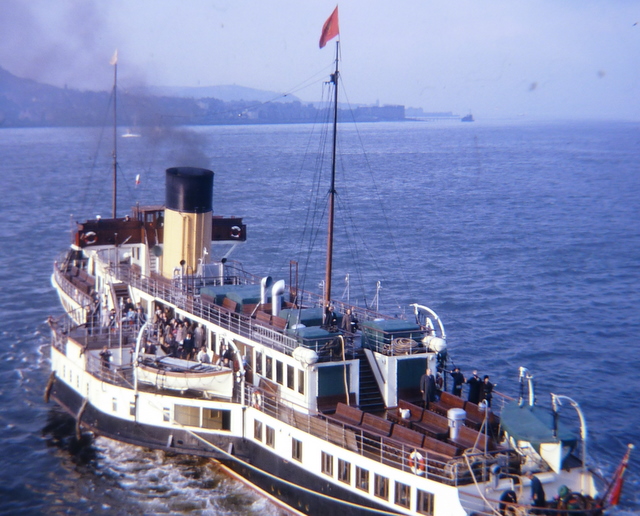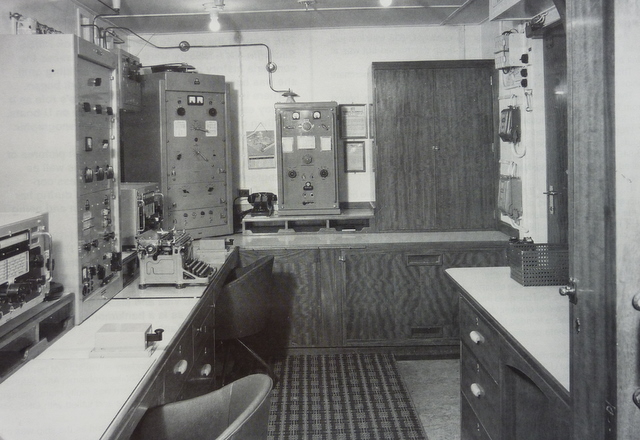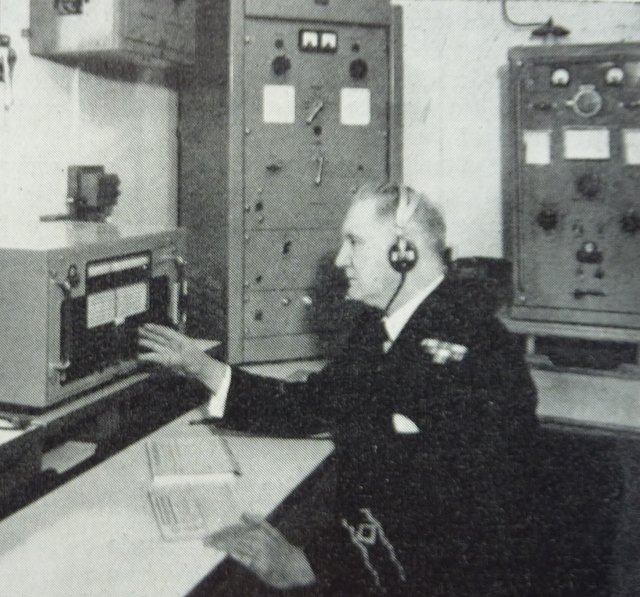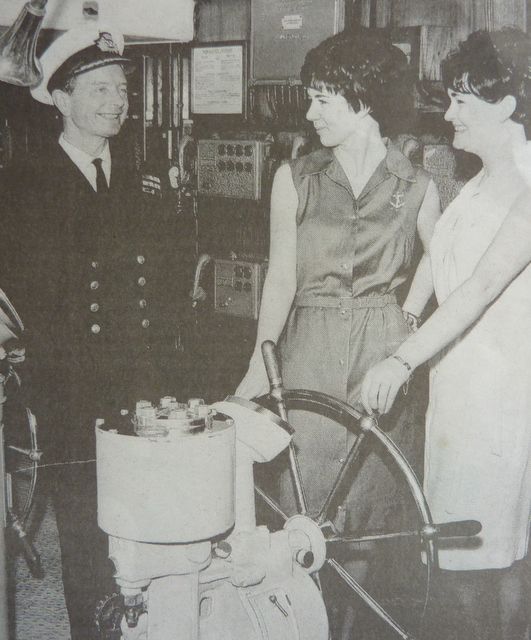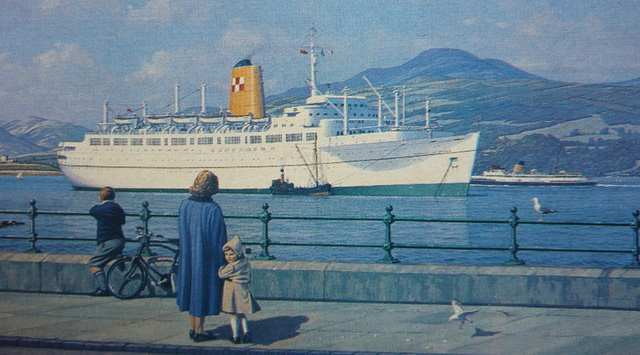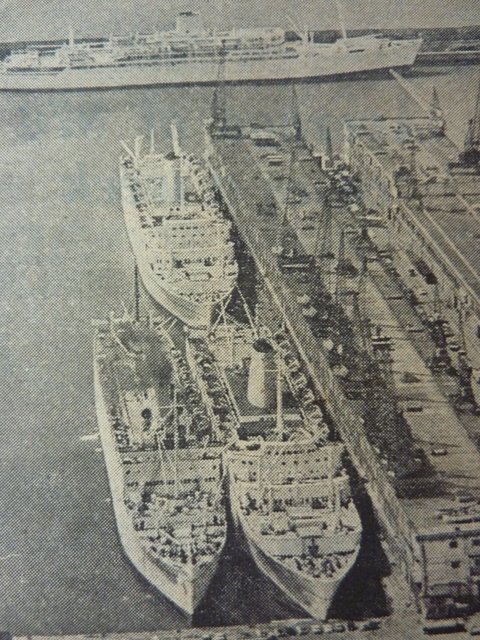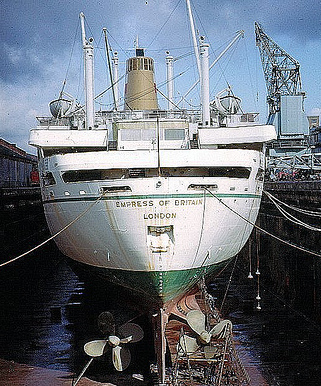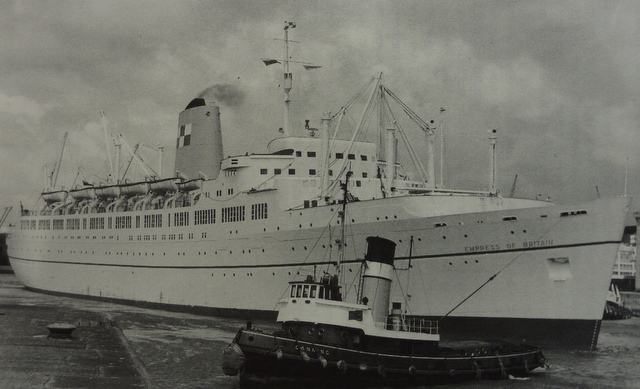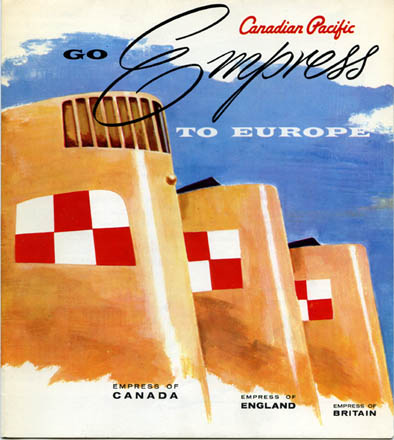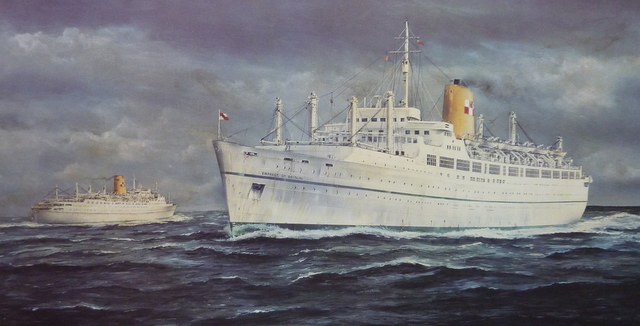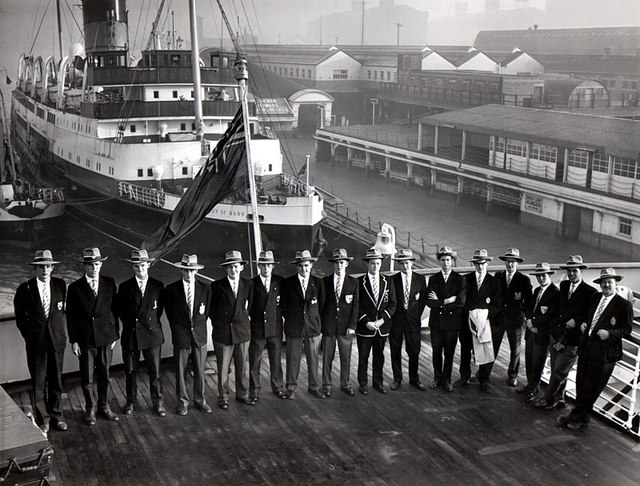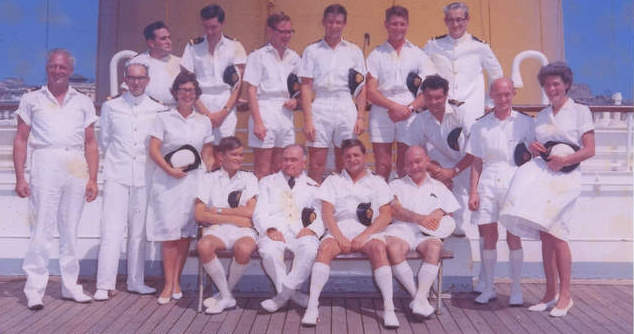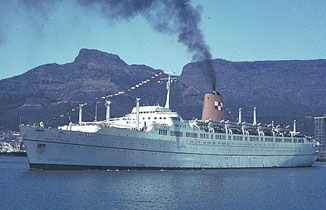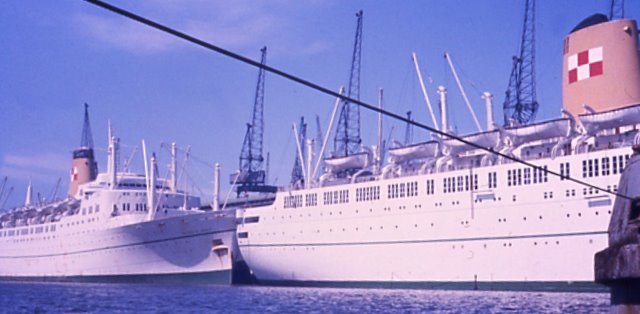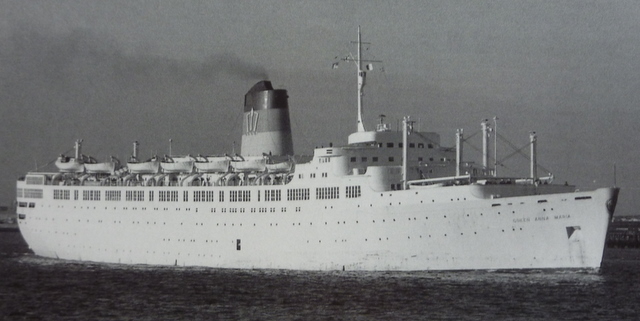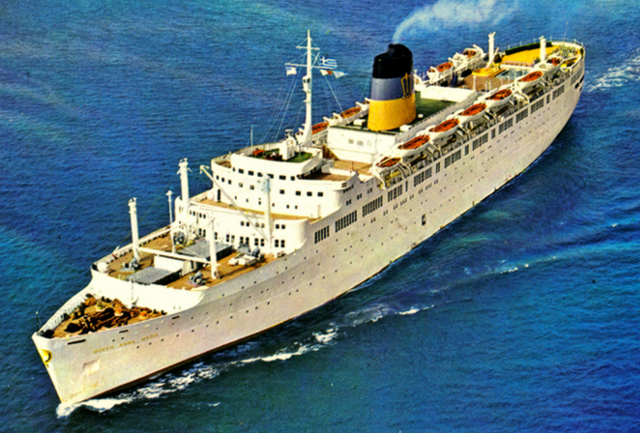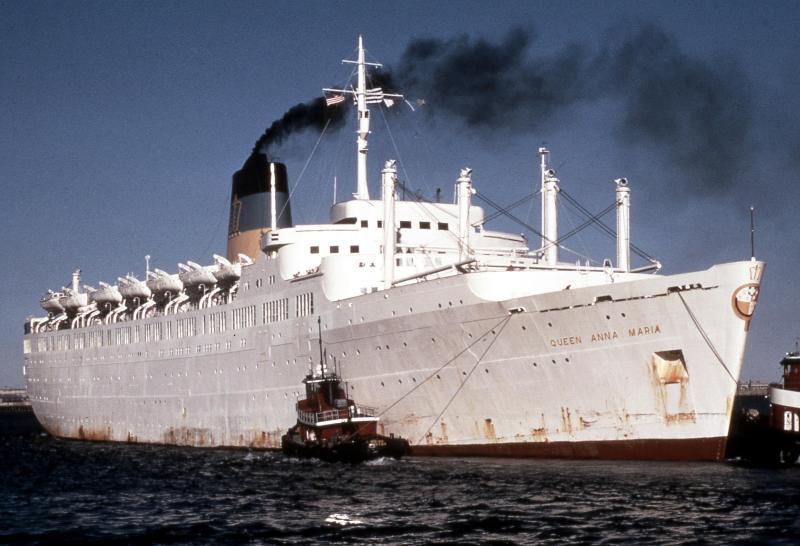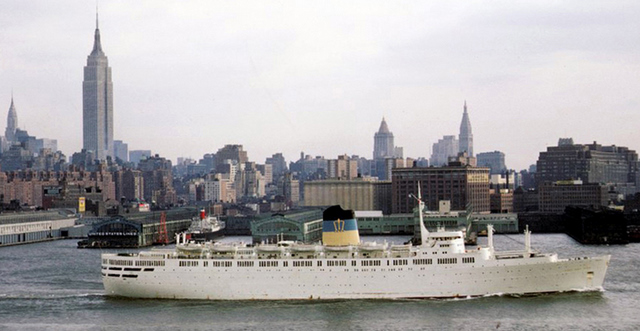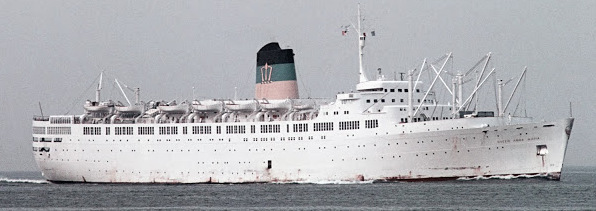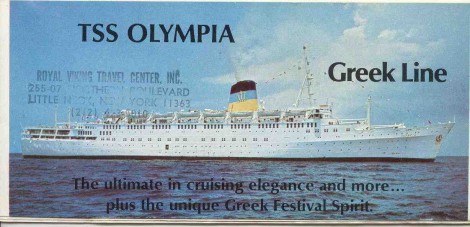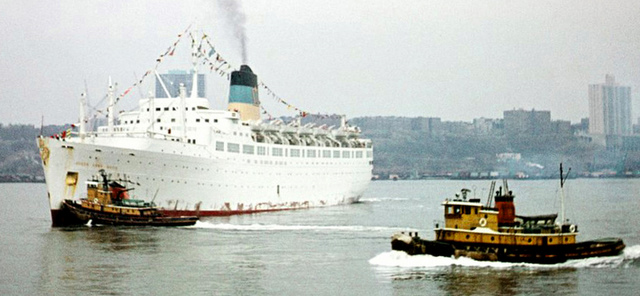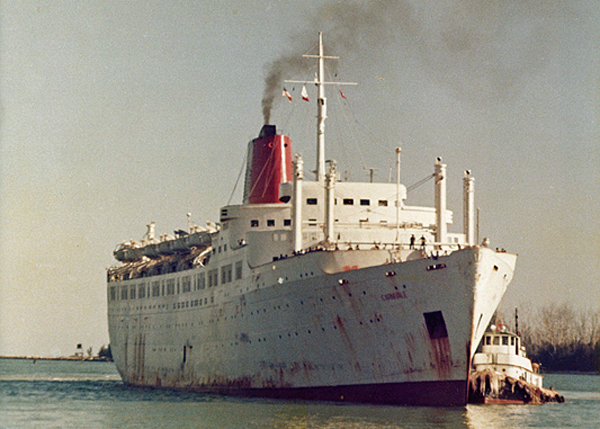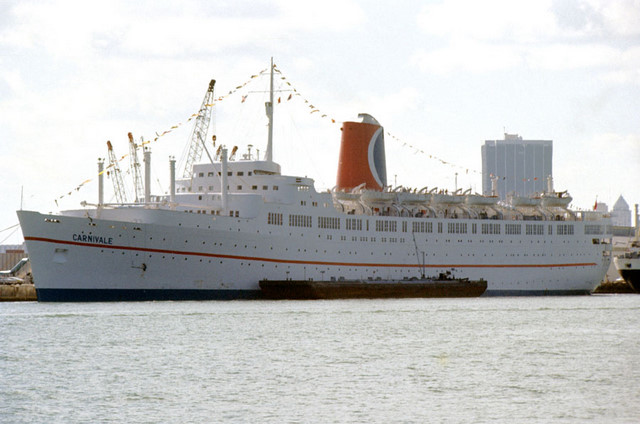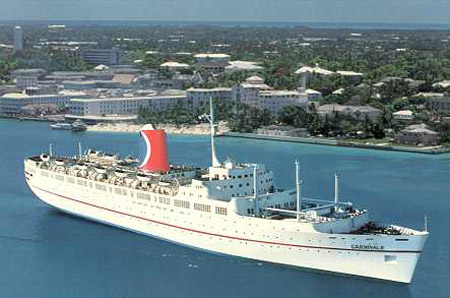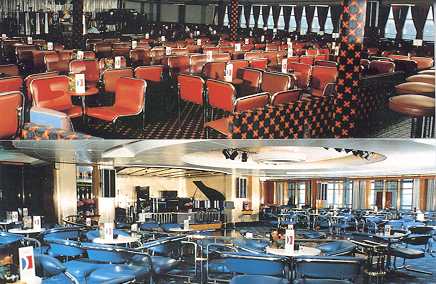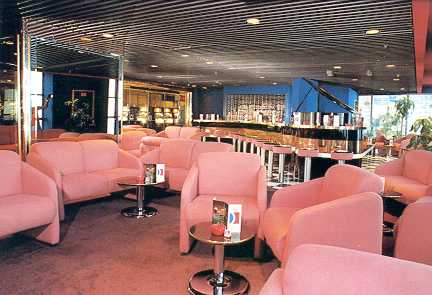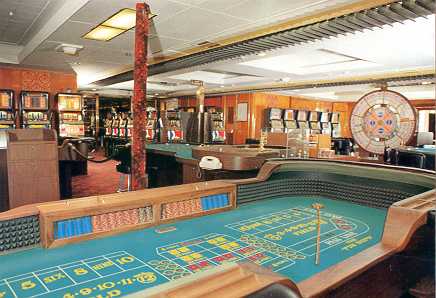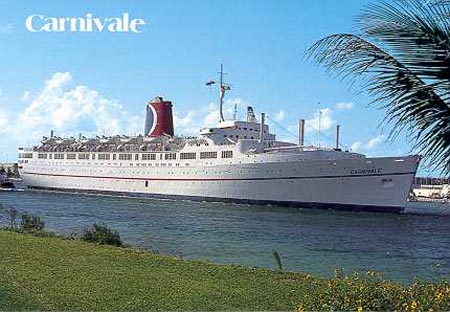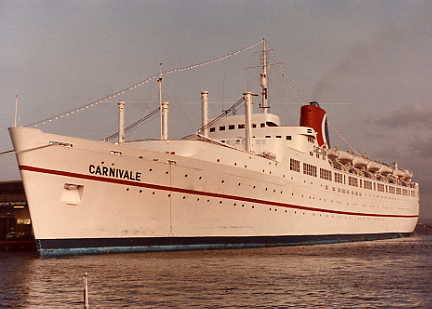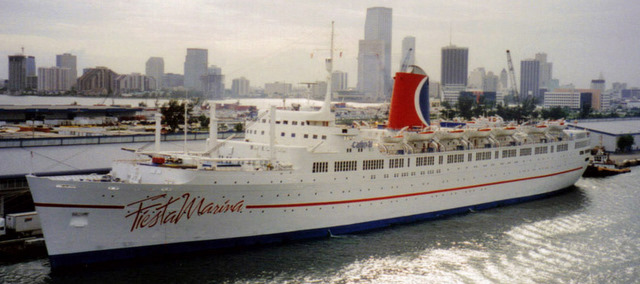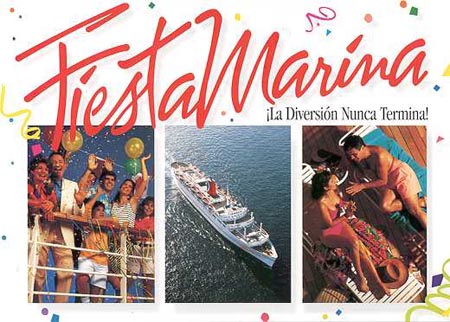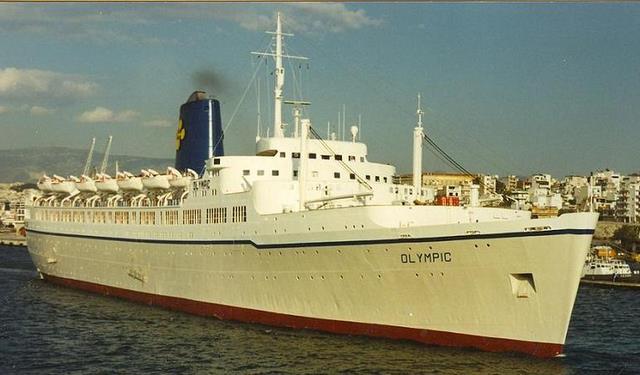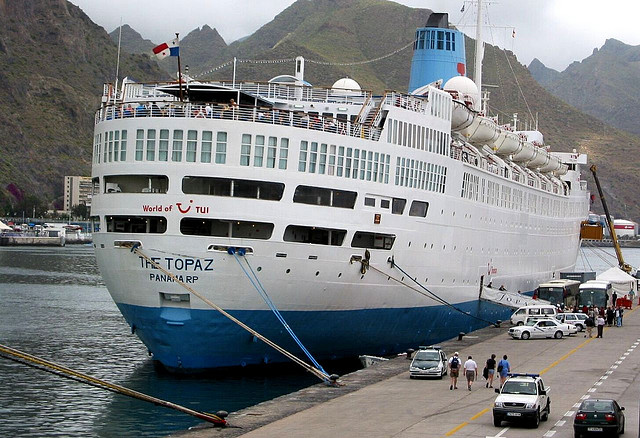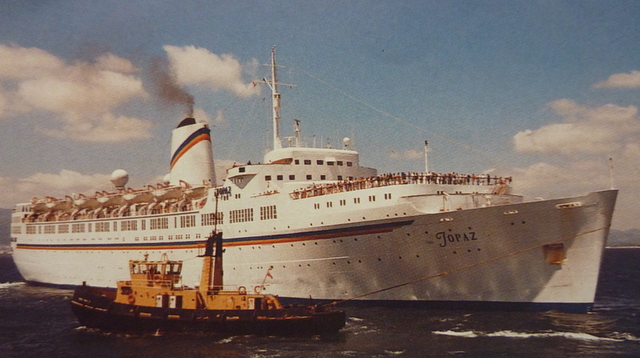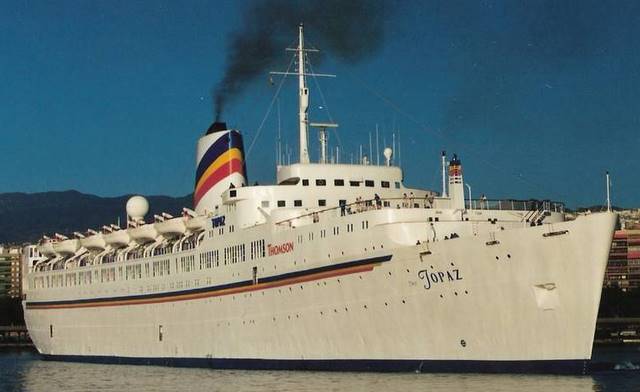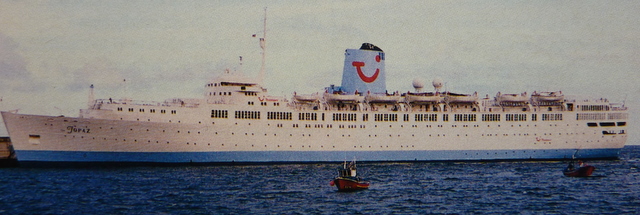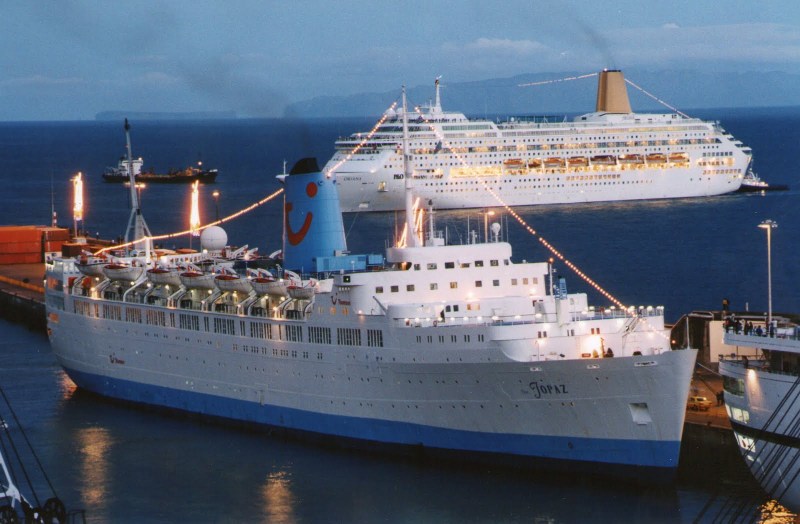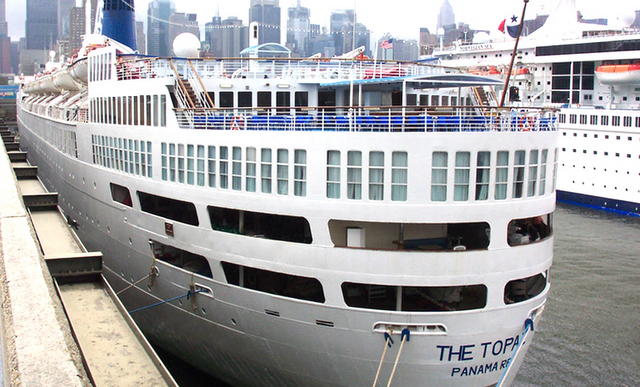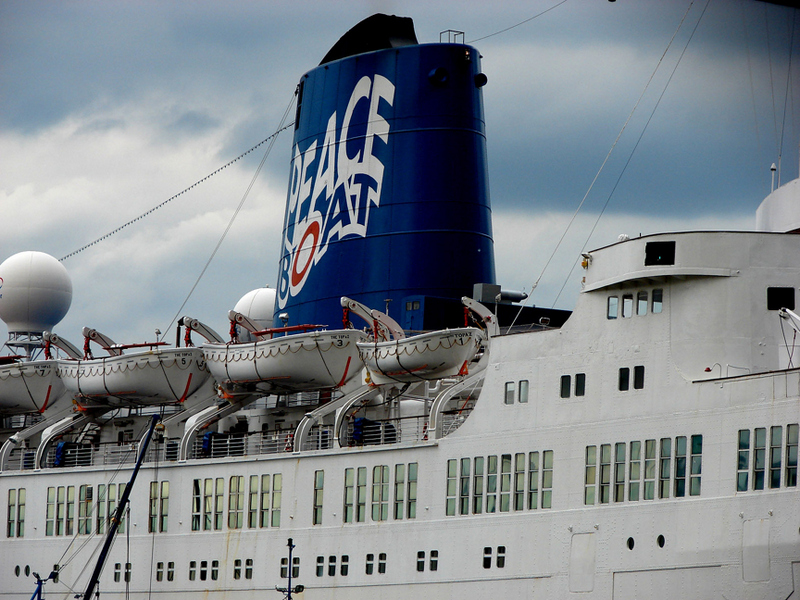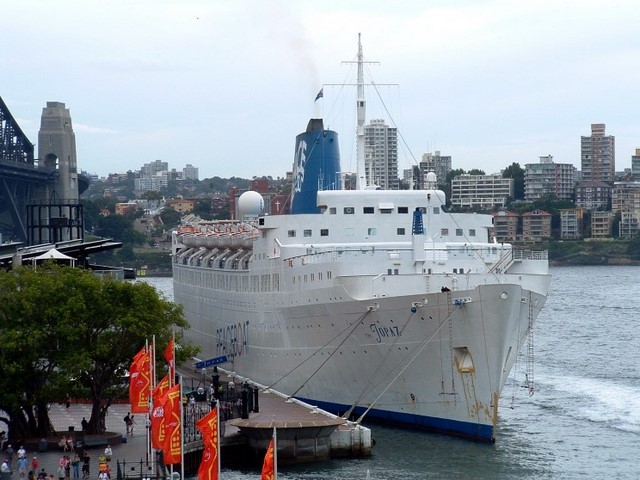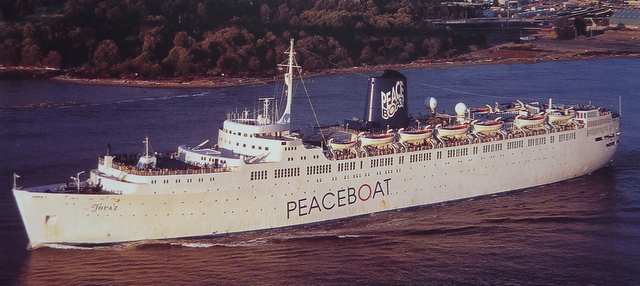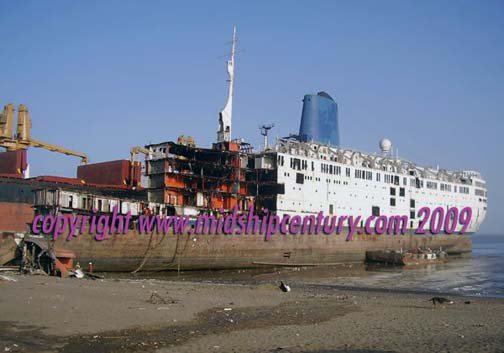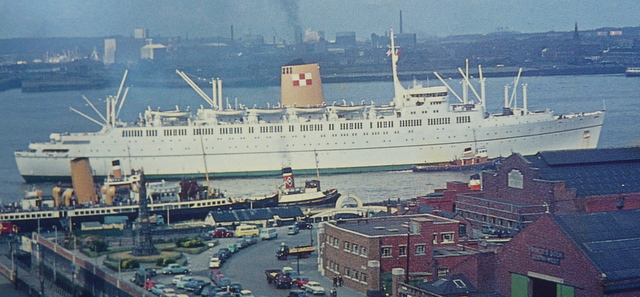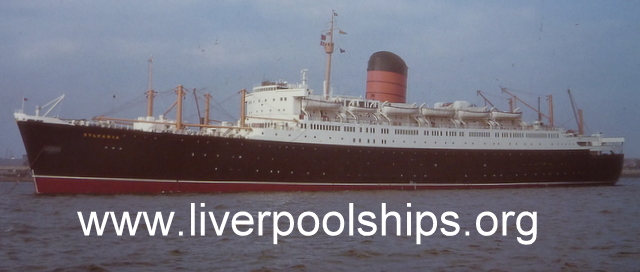LIVERPOOL SHIPS
THE CANADIAN PACIFIC LINER 'EMPRESS OF BRITAIN' OF 1956
After the Second World War, replacements were urgently needed for Canadian Pacific's ageing passenger fleet, and the situation became more serious in 1953 following the loss by fire of the EMPRESS OF CANADA. In 1951 the Cunard Line, Canadian Pacific's great rival on the Liverpool to Montreal service, had announced its intention to build a new class of passenger liner for the Canadian service. Canadian Pacific was faced with the very real need to meet the Cunard challenge in order to maintain a viable presence on the route.
Canadian Pacific waited until the first of the new Cunarders, the SAXONIA, had entered service before placing an order for a new ship which would become the EMPRESS OF BRITAIN. There is no doubt that Canadian Pacific paid very close attention to the new Cunard liner before placing an order with the Fairfield Shipbuilding and Engineering Company at Govan for the new Empress which was launched by the Queen on 22nd June 1955. The EMPRESS OF BRITAIN had the distinction of being the first Canadian Pacific liner, and the first Fairfield-built vessel, to be named by a reigning monarch. ___________________________________________________
EMPRESS OF BRITAIN : built by the Fairfield Shipbuilding and Engineering Company, Govan. Yard No: 731 Official Number: 187376 Signal Letters: G V C N Gross Tonnage: 25,516 Nett: 13,681 Length: 640ft Breadth: 85.2ft Owned by the Canadian Pacific Railway Company (Canadian Pacific Steamships - Managers) 6 steam turbines: double reduction gearing to twin screws
__________________________________________________________
Queen Elizabeth II breaks the bottle of champagne on the bows of the new EMPRESS OF BRITAIN
The new EMPRESS OF BRITAIN glides into the waters of the River Clyde at Govan
" 'Tis here that the sea-going liners are born But, unlike the salmon, they seldom return " from 'The Song of the Clyde' (Kenneth McKellar)
The new EMPRESS OF BRITAIN being manoeuvred into the fitting-out basin at the Fairfield Shipbuilding & Engineering Company's Govan yard
The Queen and the Duke of Edinburgh were entertained to lunch in the shipyard boardroom, and following the loyal toast, Vice-Admiral E.W. Longley-Cook, the managing director of the Fairfield Company, pointed out that the new EMPRESS OF BRITAIN would be the twenty-first ship built by his company for Canadian Pacific; a total which include six Empresses and eight Princesses. The association between the two companies went back fifty years to when the first EMPRESS OF BRITAIN was built at the Govan yard.
The EMPRESS OF BRITAIN of 1931 was also built on the Clyde, at the yard of John Brown & Co. at Clydebank. She is seen here shortly before being launched by Edward, Prince of Wales on 11th June 1930
On 28th October 1955, just four months after the launching of the EMPRESS OF BRITAIN, Canadian Pacific Airlines ordered three Bristol Britannia 300LR airscrew-turbine air liners, with an option for a further five. The age of the trans-ocean airliner was dawning!
Even before the new EMPRESS OF BRITAIN had sailed on her maiden voyage, Canadian Pacific was expanding its airliner services
The new Empress left the Clyde on 1st March 1956 and entered Gladstone Graving Dock at Liverpool the following day, before returning to the Clyde on 8th March to undertake her speed trials. These were run over the Arran Mile on the next two days, following which the EMPRESS OF BRITAIN was berthed in Glasgow's King George V Dock for almost three weeks. At noon on 29th March 1956 the new ship underwent further trials on the Firth of Clyde before being handed over to Canadian Pacific Steamships at a ceremony held that evening whilst the vessel was at anchor at the Tail of the Bank off Greenock.
The new EMPRESS OF BRITAIN running her speed trials over the Arran Mile in the Firth of Clyde on 9th March 1956.
The new EMPRESS OF BRITAIN in the Gladstone Graving Dock, Liverpool, on 3rd March 1956.
The EMPRESS OF BRITAIN sailed to Southampton on a 'shake-down' cruise, leaving Liverpool on 9th April with 400 guests of the Company on board. On her way down the Mersey she passed the new REINA DEL MAR, arriving from her sea trials. After arriving at the southern port on 10th April, the new Empress disembarked her passengers and took on another 400 guests for the return passage to Liverpool, arriving back in the Mersey on 12th April to prepare for her maiden voyage which left Liverpool on 20th April.
The EMPRESS OF BRITAIN at Southampton on her 'shake-down' cruise on 10th April 1956.
One shipping journalist who had been on board for the cruise described the EMPRESS OF BRITAIN as 'Britain's most interesting ship of the decade'. She was in fact the first completely air-conditioned passenger liner to have been built in Britain. Lloyd's List enthused: "For comfort and real quality in ship decoration and furnishing - indeed, luxury in many respects - Canadian Pacific's new flagship sets the highest possible standards in North Atlantic travel. This applies particularly to tourist class and the EMPRESS OF BRITAIN is primarily a tourist-class ship. The distinction between the two classes is virtually negligible, and the generous tourist-class public rooms, to say nothing of most of the cabins, are in literal truth of first-class standard".
The first-class lounge on the EMPRESS OF BRITAIN
The first-class sun lounge on the EMPRESS OF BRITAIN
The 'Empress Room' on the EMPRESS OF BRITAIN Both first-class and tourist-class passengers used this room, which was the largest public room on the ship.
The first-class dining saloon on the EMPRESS OF BRITAIN
The 'Club Room' on the EMPRESS OF BRITAIN
A first-class suite on the EMPRESS OF BRITAIN Note the 'lounge' area through the double doors
The tourist-class library on the EMPRESS OF BRITAIN
The tourist-class card room on the EMPRESS OF BRITAIN
Although essentially a passenger liner, the new Empress could also carry 3,000 tons of cargo with a large provision of refrigerated space for fruit and other Canadian produce. Bearing in mind that for at least a part of the year the ship would encounter ice conditions in the St Lawrence, the hull was suitably strengthened.
The EMPRESS OF BRITAIN embarked a full complement of 150 first-class passengers and 900 tourist-class passengers and left Liverpool on her maiden voyage on 20th April 1956, arriving at Quebec on 25th April and at Montreal on 26th April. The call at Greenock, traditionally part of the Canadian schedule, was omitted.
The EMPRESS OF BRITAIN backing off Princes Landing Stage, Liverpool
There were some minor machinery problems in June and July, but generally all went well and the new liner settled down into her trans-Atlantic schedule. On 11th September 1956 Canadian Pacific announced that the EMPRESS OF BRITAIN had broken both the eastbound and westbound records between Liverpool Bar and the St Lawrence pilot station at Father Point with an average speed of 21.43 knots.
St John, New Brunswick, was the winter terminal port between November and March when the St Lawrence was impassable due to ice.
The EMPRESS OF BRITAIN photographed in the St Lawrence on passage from Quebec to Montreal
The EMPRESS OF BRITAIN docked at Liverpool on 18th January 1957 after experiencing some trouble with her port engine off the Mersey Bar. She was due at Princes Stage at 6.30am, but sailed directly to her berth in Gladstone Dock where she arrived shortly before 3.pm. The Empress had arrived off the Bar at 2.35am and was met by the Alexandra Towing Company's NORTH LIGHT. A Canadian Pacific official said that he understood that the port engine had not failed, but was 'unreliable'. The EMPRESS OF BRITAIN had left St John, NB, six days earlier with 270 passengers.
The new EMPRESS OF ENGLAND joined the EMPRESS OF BRITAIN in April 1957. She is seen here passing under the Jacques Cartier Bridge at Montreal on her maiden voyage.
The new EMPRESS OF ENGLAND, the slightly younger sister of the EMPRESS of BRITAIN, entered service in April 1957. The newer ship was to become Canadian Pacific's cruise liner during the winter months, leaving the EMPRESS OF BRITAIN to maintain the winter trans-Atlantic schedule. In 1958 the call at the Tail of the Bank, off Greenock, was introduced into the EMPRESS OF BRITAIN's schedule.
"Will Ye No Come Back Again" ? The call at the Tail of the Bank off Greenock in the Firth of Clyde was included in the EMPRESS OF BRITAIN's schedule from 1958. She is seen here, along with her younger sister, the EMPRESS OF CANADA, in the early 1960s.
While at anchor at the Tail of the Bank, the EMPRESS OF BRITAIN would be tendered by one of the Caledonian Steam Packet Company's steamers, bringing out passengers and their baggage from the quay at Greenock. On this occasion the paddle steamer CALEDONIA has been pressed into service.
An ice jam in the St Lawrence in mid-April 1959 caused problems. The EMPRESS OF BRITAIN was damaged trying to force her way through ice at Sorel, some thirty miles from Montreal. The Empress, along with Cunard's CARINTHIA, was trapped at Montreal for some days until the jam broke up.
The EMPRESS OF ENGLAND's winter cruising programme had been such a success that Canadian Pacific decided it would be far more profitable to send the EMPRESS OF BRITAIN cruising as well, rather than to retain one of the new ships on a winter trans-Atlantic service. Cunard was having similar difficulties in profitably employing its four Canadian ships in the winter months, and the Canadian Pacific ships lent themselves far more readily to cruising than the Cunarders which were primarily emigrant carriers with only very partial air-conditioning.
The Radio Room on the EMPRESS OF BRITAIN
One of the EMPRESS OF BRITAIN's three radio officers
Captain Richard Walgate, Master of the EMPRESS OF BRITAIN, shows a couple of passengers around the bridge.
Both the new Empresses were overhauled at Liverpool in December 1959 and sailed for New York, where they arrived in mid-January 1960 for three months of cruising to the Caribbean.
The EMPRESS OF BRITAIN at anchor at the Tail of the Bank, off Greenock. Note the Clyde 'puffer' alongside loading the mails, and the Caledonian Steam Packet Company's QUEEN MARY II passing the Empress's bows. From an original painting by Frank Bauwen
The year 1960 was severely disrupted by industrial action at the height of the passenger season. When the EMPRESS OF BRITAIN arrived at Liverpool on 19th July, most of her crew joined an unofficial strike over pay and hours. However, efforts to recruit a full crew for her departure scheduled for 22nd July succeeded and she left Princes Landing Stage at noon and anchored in mid-Mersey to await the Greenock passengers who were on a special train to Liverpool Riverside Station, and who were taken out to join the liner by a Mersey ferry. The crew situation could not be resolved for the 12th August departure from Liverpool and the EMPRESS OF BRITAIN's sailing was cancelled and her 600 passengers travelled with Canadian Pacific Airlines. The unofficial strike action dragged on into September 1960, and over 1,000 passengers booked to sail on the EMPRESS OF BRITAIN's 2nd September departure had to accept alternative ways of reaching Canada. It was not until 10th September that the EMPRESS OF ENGLAND was able to resume the sailing schedule, and it was 24th Septembeer before the EMPRESS OF BRITAIN sailed, having lost two round voyages at the peak of the season.
In July and August 1960, the entire Canadian Pacific fleet was strikebound in Gladstone Dock, Liverpool. The EMPRESS OF BRITAIN, the EMPRESS OF ENGLAND and the EMPRESS OF FRANCE are all idle as the strike drags on. In the background is the strikebound REINA DEL MAR
The EMPRESS OF BRITAIN docked at Quebec on 5th April 1961 with 525 passengers after being delayed for a day by thick pack ice in the Gulf of St Lawrence. The voyage did not proceed to Montreal and the Empress left Quebec with 800 passengers on schedule.
The EMPRESS OF BRITAIN undergoing overhaul in the Gladstone Graving Dock, Liverpool
More unofficial industrial action dogged the EMPRESS OF BRITAIN in 1961. Her 18th April departure was delayed for twenty-four hours by members of the National Seamen's Reform Movement. Engine trouble delayed her sailing from Montreal on 19th May, and her 14th November departure from Liverpool was set back for thirty-six hours by renewed unofficial strike action.
The EMPRESS OF BRITAIN leaving her berth in Gladstone Dock, Liverpool, and manoeuvring into the river entrance lock before embarking passengers at the Princes Landing Stage.
Some 200 crew members were demanding the dismissal of the boatswain and walked off the ship at the landing stage. The 350 passengers on board were looked after by the remainder of the crew. In a statement Canadian Pacific said: "It is clear that the whole affair has been engineered by the same subversive elements who have taken similar action in the past and whose avowed intention is to disrupt British shipping".
The EMPRESS OF BRITAIN sailed in the early morning of 16th November with a full crew who had been signed-on during the night. The 200 crew members who had walked off, and who had been told by strike leaders that 'she can't sail without us' arrived for a meeting on the landing stage to find that she had indeed sailed without them! Jim Scott, the general secretary of the National Union of Seamen, said: "These men had fair warning. They were told to return to the ship on an assurance of an investigation of their complaints. Their discharge books have been stamped 'Voyage Not Completed', and now they will have to go into the pool to take their turn for jobs." The EMPRESS OF BRITAIN cut out her Greenock call to make up time and her Scottish passengers were switched to Cunard's CARINTHIA. Mr Norris R. Crump, chairman and president of the Canadian Pacific Railway Company, said that his company must reserve the right to leave the port of Liverpool for some other port where continuity of operation could be obtained.
The EMPRESS OF BRITAIN continued to operate a winter trans-Atlantic schedule until 13th January 1962, after which time Canadian Pacific abandoned all attempts at operating such sailings which had become unprofitable due to the low passenger numbers. After completing her annual overhaul the Empress went cruising from the UK until returning to her designed route from Liverpool to Montreal for the 1962 summer.
The EMPRESS OF BRITAIN passing her younger sister, the EMPRESS CANADA, in mid-Atlantic. (from an original painting by Robert Lloyd)
The three Canadian Pacific Empresses made thirty-three round voyages between Liverpool and Canada in 1962 - never again would such an intensive schedule be operated. From January to April 1963 the EMPRESS OF BRITAIN was employed on a cruising programme from the UK, and it was not until 30th April that she returned to the Liverpool to Montreal route. Passenger numbers on the North Atlantic began an accelerated terminal decline in 1963 and the EMPRESS OF BRITAIN made her 108th and final round voyage to Canada, leaving Liverpool on 24th September.
Members of the Canadian Rowing Club returning home from Liverpool to Montreal on the EMPRESS OF BRITAIN in 1963. In the centre of the photograph, wearing the blazer with the braid, is Neil Thomas of the Liverpool Victoria Rowing Club. In the background is the Isle of Man Steam Packet Company's centenary steamer LADY OF MANN of 1930.
South African entrepreneur Max Wilson had set up the Travel Savings Association (TSA) in 1963, promoting cheap 'no-frills' cruises. Potential passengers paid instalments into TSA's savings scheme, eventually using the money to buy inexpensive cruises. Initially the scheme seemed to meet with great success. Canadian Pacific acquired a fifty-one per cent controlling interest in the new company and both the EMPRESS OF BRITAIN and the EMPRESS OF ENGLAND went on charter to the Travel Savings Association.
The Purser's Staff on the EMPRESS OF BRITAIN photographed in their white tropical rig whilst on a TSA cruise.
On 25th October 1963 the EMPRESS OF BRITAIN sailed from Liverpool on her first TSA cruise. On 4th December she left for South Africa, carrying 570 emigrants travelling under the South African Government's assisted passage scheme. The Empress arrived at Cape Town on 19th December and two days later sailed on her first cruise across the South Atlantic to South American ports.
The EMPRESS OF ENGLAND at Cape Town on charter to the Travel Savings Association.
TSA's original charter of the EMPRESS OF BRITAIN had been for five years, but early in 1964 it exercised its option to terminate the charter as from 5th January 1965. Shortly afterwards it was announced that TSA would cease trading at the end of 1964 as it had not developed into the success that had been envisaged. On 13th February 1964 the EMPRESS OF BRITAIN left Cape Town for Liverpool, where she arrived on 28th February.
Canadian Pacific stated that "the economics of passenger operations are not what they should be", and by that time the EMPRESS OF BRITAIN had arrived back in the Mersey and had been sold to the Goulandris-owned Greek Line for $8 million. The Empress spent the next six months undertaking cruises under her TSA charter, and arrived back in Liverpool on 22nd August 1964 on completion of her TSA duties. She was temporarily laid up, awaiting her delivery to the Greek Line. For the ship herself, this was a new beginning. She had more than proved her versitality both as an Atlantic liner and as a cruise ship.
The EMPRESS OF BRITAIN (on the right) and the EMPRESS OF CANADA together in the Canadian Pacific berth in No.1 Branch, Gladstone Dock, Liverpool
The EMPRESS OF BRITAIN was renamed QUEEN ANNA MARIA and left Liverpool under this name on 18th November 1964, bound for Genoa where she arrived on 22nd November. The ship was flying the Greek flag, and three painters had been employed to paint her new name in Greek characters on the stern and bows. Just before sailing time the painters were back, reinstating the English lettering, because the new owners felt that this was in accordance with accepted practice.An official of the marine surveyor's office at the Ministry of Transport commented: "As far as we know, there is no compulsion for a Greek ship to have her name in English lettering."
The Greek Line's QUEEN ANNA MARIA formerly Canadian Pacific's EMPRESS OF BRITAIN
The former EMPRESS OF BRITAIN spent the next three months at the Mariotti shipyard where the cabin accommodation was increased and the ship was made more suitable for a Mediterranean Atlantic service, rather than the North Atlantic. The total passenger complement increased to 1,313 on the Atlantic run, and 742 whilst cruising. The original steam turbines were retained. The outward appearance was little changed, except at the stern, where a large night club and lido deck were constructed. The overall character remained and the essentially British-styled North Atlantic liner decor was retained intact.
The QUEEN ANNA MARIA (ex EMPRESS OF BRITAIN) in Greek Line colours
The QUEEN ANNA MARIA's refit was completed on 6th March 1965 and she arrived at Piraeus three days later. Her first Atlantic crossing for the Greek Line left Piraeus on 23rd March and she called at Naples, Palermo and Lisbon. A call was made at Halifax, N.S., and the QUEEN ANNA MARIA arrived in New York on 5th April. She settled into a routine of spending the summer on the Atlantic and cruising in the winter. On 19th February 1967, whilst arriving at Kingston, Jamaica, the QUEEN ANNA MARIA ran aground and was not refloated until a week later. Towards the end of 1967, three-night 'cruises to nowhere' from New York were slotted in between Atlantic crossings.
The QUEEN ANNA MARIA leaving New York
The Greek Line worked the QUEEN ANNA MARIA hard. Her summer seasons on the Atlantic run became increasingly short and cruising became her principal occupation. In the early 1970s the Greek Line was struggling to remain viable in the face of ever increasing costs, but following the death of its owner and chairman, Basil Goulandris, the company seemed to lose its vigour and momentum. The four-fold increase in the price of oil over the winter of 1973/74 was the final blow. The QUEEN ANNA MARIA sailed on in 1974 amidst mounting debts, and in January 1975 the Greek Line issued a statement to the effect that financial difficulties had made it impossible to continue with the cruise programme.
The OLYMPIA - the QUEEN ANNA MARIA's running-mate
As one of the Greek Line's only two assets (the other was the OLYMPIA), the QUEEN ANNA MARIA was tied up at New York and the creditors made arrangements to seize her. However, forewarned that this was about to happen, her crew prepared for a quick and unannounced departure on 11th January 1975. It was a particularly ignominious farewell. On 22nd January the QUEEN ANNA MARIA arrived in Piraeus and was laid up at Perama along with many other redundant passenger liners.
A quick and unannounced departure from New York as the QUEEN ANNA MARIA slips away from her creditors
With the Greek Line in receivership, the Chase Manhattan Bank, which held the mortgage on the QUEEN ANNA MARIA, was anxious to dispose of her, and made her available for sale at a very low price.
The CARNIVALE (ex QUEEN ANNA MARIA, ex EMPRESS OF BRITAIN) arriving at Miami on 1st January 1976 to join her younger sister, the MARDI GRAS (ex EMPRESS OF CANADA) in Ted Arison's fledgling Carnival Cruise Line's fleet.
After a quick refit, the QUEEN ANNA MARIA (ex EMPRESS OF BRITAIN) entered service as the CARNIVALE in mid-February 1976.
In January 1972 Ted Arison had made arrangements for purchasing the EMPRESS OF BRITAIN's younger sister, the EMPRESS OF CANADA, then laid up at Tilbury. On 21st March the EMPRESS OF CANADA was renamed MARDI GRAS, and five days later she sailed for Miami to be operated by the newly formed Carnival Cruise Lines. Three years later Ted Arison was looking for a running-mate for the MARDI GRAS and inspected the QUEEN ANNA MARIA. The Sitmar Line (purchasers of Cunard's CARINTHIA and SYLVANIA) was also interested and Arison had to move fast. He bought the QUEEN ANNA MARIA (ex EMPRESS OF BRITAIN) for $3 million. The ship was immediately prepared for sea and arrived at Miami on New Year's Day 1976 and was renamed CARNIVALE. In mid February 1976 the CARNIVALE entered service for Carnival Cruise Lines, sailing in company with her younger sister, the MARDI GRAS (ex EMPRESS OF CANADA). Of the two ships the CARNIVALE was better suited to cruising, given the extensive rebuilding carried out by the Greek Line.
The CARNIVALE
The Showplace Lounge and the Mardi Gras Nightclub on the CARNIVALE
The Riverboat Lounge on the CARNIVALE
The Riverboat Club Casino on the CARNIVALE
The CARNIVALE was still an Atlantic liner at heart, and during her first months with Carnival Cruise Lines she underwent upgrading and refitting. Both the CARNIVALE and the MARDI GRAS were marketed as 'fun ships' and became phenomenonally successful on the seven-day circuit from Miami, calling at San Juan, St Maarten and St Thomas. The two ships had enjoyed some measure of success with Canadian Pacific, but this had been rather short-lived due to the changing patterns of trans-Atlantic travel. Under the guiding hand of Ted Arison, the two former Empresses achieved undreamed-of success.
As the CARNIVALE, the former EMPRESS OF BRITAIN achieved undreamed-of success.
The CARNIVALE sailed on as part of Carnival Cruise Line's ever expanding fleet until October 1993 when she was renamed FIESTA MARINA and transferred to a Carnival subsidiary, FiestaMarina Cruises. The former EMPRESS OF BRITAIN was now thirty-eight years old, and after eighteen years of popularity and success with Carnival, she could not compete with the newer and much larger purpose-built cruise ships. The FIESTA MARINA was based at San Juan for three months, but this proved to be a costly failure, after which she returned to her more familiar Miami base. In September 1994 the old ship sailed on her final cruise after which FiestaMarina Cruises was wound up and the ship laid up.
The FIESTA MARINA was not a success
The former Canadian Pacific Empress was quickly purchased by the Greek Epirotiki Lines and left Miami for the Mediterranean on 14th September 1994 where she was renamed OLYMPIC. She was in impeccable condition, having been flawlessly maintained by Carnival over the years. A correspondent sailed on her in August 1997 and reported that "the OLYMPIC's public rooms are a mix of vintage Canadian Pacific and 1980s Carnival glitz. The cinema remains untouched since the ship's Canadian Pacific days, with its polishd wood and leather-trimmed bulkheads, plastic acoustic ceiling and vivid red seating."
The former EMPRESS OF BRITAIN sailing as the OLYMPIC for Epirotiki Lines
The OLYMPIC was based at Piraeus and operated three and four day cruises in the Aegean. Such was her success that there was speculation that her younger sister, the former EMPRESS OF CANADA, which at that time was languishing in lay-up at Perama Bay, near Piraeus, might join her. However, at the end of the 1997 cruising season, Epirotiki Lines announced the disposal of the OLYMPIC and she was sold to a Panamanian registered company, Topaz International.
THE TOPAZ at Santa Cruz de Tenerife whilst on Thomson charter
On 19th January 1998 the forty-three year old ship was taken to Skaramanga shipyard for refit. She was renamed THE TOPAZ and was chartered to Thomson Holidays. THE TOPAZ's first cruise was a transatlantic crossing to Port Everglades, but unfortunately her entry into service was marred by bad publicity generated by passenger complaints. It would appear that the final stages of the refit had been hurried, and that the crew had not had sufficient time to familiarise themselves with the ship. As a result, by the time that THE TOPAZ arrived at Malta, Thomson had received many complaints about problems with meals, poor service and run-down facilities, and the 756 passengers were taken off the ship.
As THE TOPAZ, the former EMPRESS OF BRITAIN enjoyed great popularity whilst on charter to Thomson
Fortunately, this proved to be a temporary blip, and THE TOPAZ quickly became one of the most popular cruise ships. During the summer of 1999 Thomson based THE TOPAZ at Palma, but on 28th October she sailed to the Caribbean for a six-month cruising season. She returned to Palma in April 2000 for a further programme of Mediterranean cruising for Thomson.
THE TOPAZ painted in Thomson's new corporate livery during her final year on charter to Thomson Holidays
THE TOPAZ (ex EMPRESS OF BRITAIN) alongside at Funchal, Madeira, on New Year's Eve 2002. In the background is P&O's ORIANA
In May 2002 it was announced that Thomsons' five-year charter of THE TOPAZ would come to an end in May 2003 and would not be renewed. With the best will in the world, THE TOPAZ, one of the world's oldest operational cruise ships, could just no longer compete, and Thomsons had negotiated the charter of the former Holland-America cruise ship NIEUW AMSTERDAM to replace her. It seemed that the writing was on the wall for the former EMPRESS OF BRITAIN.
The stern of THE TOPAZ, clearly showing the lido deck and night club built on to the former EMPRESS OF BRITAIN by the Greek Line during the ship's spell as the QUEEN ANNA MARIA
The familiar Canadian Pacific funnel remains in place
In early November 2003 came the news that THE TOPAZ was to be chartered by the Japanese educational organisation Peace Boat. She was scheduled to make four round-the-world cruises for them, the first to commence on 14th June 2003, and the Peace Boat charter would extend until 2006.
Sailing for the Japanese Peace Boat Organisation, THE TOPAZ is berthed adjacent to the Sydney Harbour Bridge.
THE TOPAZ arrived at Tokyo on 10th June 2003 and shortly afterwards sailed on her first cruise for Peace Boat. This involved revisiting some of her old haunts; for instance she sailed into New York on 8th August for a three-day stay, after an absence of 28 years. On 31st August 2003 THE TOPAZ entered the harbour at Vancouver, the first time that an Empress liner had been in the port for over sixty years. In 2004 THE TOPAZ called at Piraeus on 13th August, the first day of the Athens Olympic Games, and a couple of weeks later she made a call at Tilbury. THE TOPAZ was back in the Irish Sea on 31st July 2007 when she called at Dublin on a voyage from Bergen to New York. Sadly she never returned to the Mersey.
Even at the grand old age of 52, THE TOPAZ was still instantly recognisable as Canadian Pacific's EMPRESS OF BRITAIN of 1956
In the Spring of 2008 news came that the Peace Boat Organisation would not be renewing the charter, spelling the end for Liverpool's longest serving ocean liner. The reason cited was high fuel costs. After the termination of the charter THE TOPAZ's owners, Kyma Shipping, immediately sold the former EMPRESS OF BRITAIN, as scrap metal prices were at an all time high. The old Canadian Pacific Empress was beached at Alang, India, on 4th July 2008 for demolition, almost fifty-two years to the day since her maiden voyage from Liverpool.
Alang again, naturally ...... Canadian Pacific's EMPRESS OF BRITAIN of 1956 was demolished on the beach at Alang, India, at the end of 2008.
When the Queen launched the EMPRESS OF BRITAIN back in 1955, nobody could possibly have envisaged the way things would turn out. The trans-Atlantic market entered rapid and terminal decline within five years of her maiden voyage, but the EMPRESS OF BRITAIN sailed on, and apart from eleven months of inactivity following the collapse of the Greek Line, the ship was in almost continuous operation from the day of her maiden voyage in April 1956 - an incredible fifty two years. <<<<<>>>>>
The EMPRESS OF BRITAIN approaching Princes Landing Stage at Liverpool in the late 1950s at the start of another voyage to Quebec and Montreal. At this time nobody could have envisaged the way things would turn out.
__________________________________________________________
_____________________________________________________________
|

